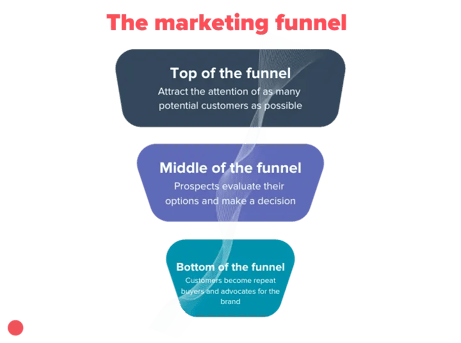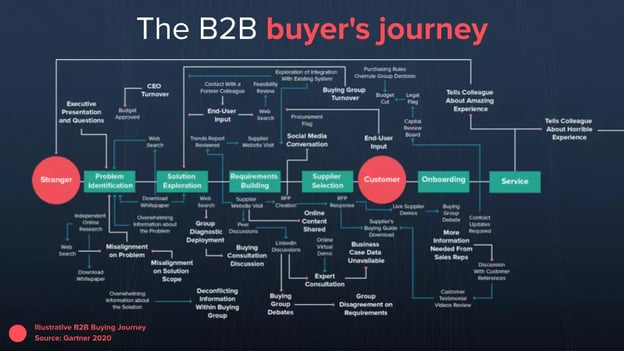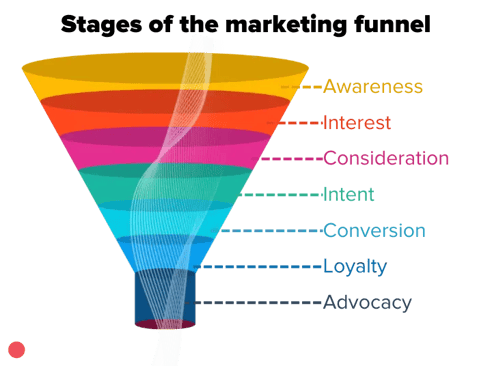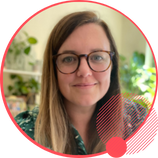In this article, we explore the differences between the marketing funnel vs customer journey and how businesses can leverage them to effectively engage and convert potential customers.
When it comes to understanding the customer's path to purchase, two popular concepts come to mind: the marketing funnel and the customer journey.
While related, these two concepts have their unique perspectives and approaches to understanding customer behaviour.
For example, imagine a potential customer first encounters an advertisement for a new fitness app (marketing funnel's 'awareness' stage).
Intrigued, they research the app, comparing it with others (customer journey's 'consideration' phase), and download other pieces of content or interact with other touchpoints, which creates their unique customer journey as they move down the funnel before eventually downloading the app and subscribing (marketing funnel's 'action' stage).
This journey highlights how the customer’s path intertwines with both the marketing funnel and the customer journey, showcasing their unique contributions to understanding consumer behaviour.
Decoding the marketing funnel: Your guide to navigating customer conversion
The marketing funnel is a crucial part of any successful business.
It helps businesses to categorise and analyse the customer journey, from initial awareness to ultimate action.
Different models exist, which reflect the various needs of companies. A popular funnel model is the AIDA model which stands for awareness, interest, desire and action.
This model outlines the process a customer goes through before taking action and making a purchase – from when they first learn about your product or service, all the way to when they make a purchase.

A more granular look at marketing funnels consists of many stages such as awareness, consideration, conversion, and loyalty.
But all these stages can be simplified into three: the top (ToFu), middle (MoFu) and bottom (BoFu) of the funnel.
At each stage prospects engage differently with products or services; in ToFu prospects become aware of problems that can be solved with your product or service; in MoFu prospects explore solutions to solve their problems; finally, in BoFu prospects who are deciding whether to take action, make a purchase, and become a customer.
Each stage serves very different functions within an organisation's sales process and needs specific strategies tailored to it to ensure success.
Businesses must understand how their marketing funnel works if they hope to be successful in reaching and converting potential customers.
Exploring the customer journey: Understanding the complete experience
The customer journey is a holistic experience that encompasses all touchpoints and interactions a customer has with a company, both online and offline.
This journey includes every step of the customer's experience, from the initial awareness of a brand or product, to the purchase, and beyond to post-purchase interactions.
The concept of the customer journey developed after the marketing funnel as marketers sought to understand the full scope of consumer behaviour and decision-making processes.
It is rooted in the study of consumer behaviour, recognising that customers may interact with a company in multiple ways before making a purchase.
This understanding enables businesses to provide a seamless and cohesive experience across all touchpoints, ultimately leading to increased customer satisfaction and loyalty.
The customer journey is a fundamental aspect of modern marketing, providing businesses with a comprehensive understanding of customer behaviour and opportunities for meaningful engagement.
Charting the course of the consumer experience with customer journey maps
Customer journey maps are important tools used by businesses to understand and visualise the end-to-end customer experience.
These maps focus on capturing the different touchpoints, need states, barriers, worries, questions, and motivations that a customer encounters throughout their journey with a product or service.
By visualising the entire customer journey, businesses are empowered to make value-driven decisions that improve the overall customer experience.
The main purpose of customer journey maps is to understand and anticipate customer behaviours to identify and address pain points and opportunities for improvement.
This visualisation allows businesses to identify important customer insights and make data-driven decisions to enhance the overall customer experience.
The key elements of a customer journey map include the different touchpoints where customers interact with the brand, the need states that drive their behaviour, the barriers that may hinder their experience, as well as their worries, questions, and motivations throughout their journey.
Check out our customer journey map template to help ensure that your business can deliver a seamless and personalised customer experience, ultimately leading to increased customer satisfaction and loyalty.
Marketing funnel vs customer journey: Spotting the key differences
The key difference between the marketing funnel vs the customer journey lies in their focus and nature. The marketing funnel primarily aims to guide potential buyers through a linear process, from awareness to the final purchase decision.
In contrast, the customer journey encompasses the entire experience with a company, taking a more circular and nonlinear route that includes all touchpoints.
The marketing funnel is mainly focused on company-controlled interactions, such as marketing campaigns and direct sales efforts, to move prospects towards making a purchase.
On the other hand, the customer journey includes organic content and interactions, such as customer reviews, social media engagement, and word-of-mouth recommendations, which also play a significant role in shaping the overall experience.
While the marketing funnel is more oriented towards the transactional aspect of the customer relationship, the customer journey emphasises building long-term relationships and fostering customer loyalty.
Synergising the journey and funnel: Integrating consumer experience with marketing strategy
The buyer's journey and marketing funnel go hand in hand, representing the different stages of the consumer experience and how it aligns with revenue-focused marketing strategies.
While the customer journey continues post-sale, the buyer's journey encompasses the process a consumer goes through from initial awareness to the final decision of making a purchase.
This perfectly aligns with the marketing funnel, which illustrates the stages of potential customers' interactions with a brand, from initial contact to conversion.
The top-of-funnel stage of the marketing funnel represents the awareness stage in the buyer's journey, where consumers become aware of a problem or need.
The middle-of-funnel stage corresponds to the consideration stage, where consumers evaluate different solutions or options.
Finally, the bottom-of-funnel stage aligns with the decision stage in the buyer's journey, where consumers are ready to make a purchase.
Understanding this alignment is crucial for marketers to effectively guide consumers through the journey and ultimately drive revenue for their business.
B2B funnels unveiled: Mastering the complexities of business-to-business marketing
B2B funnels, in contrast to B2C marketing funnels, involve longer sales cycles and more complex buying decisions.

The bottom of the funnel is crucial in B2B marketing, where prospects actively seek the specific products or services they need to address their business challenges.
It's important to have targeted content and messaging at this stage, as prospects are closer to making a purchase decision.
SEO and PPC play a critical role in converting prospects at the bottom of the funnel. By optimising for specific keywords that prospects use when they are ready to make a purchase, B2B companies can ensure that their offerings are visible and easily accessible.
For example, keywords like "B2B software solutions," "enterprise IT services," or "business consulting firms" are commonly used by prospects at the bottom of the funnel.
The nuances of B2B funnels require a deep understanding of the buyer's journey and the ability to provide tailored solutions at the bottom of the funnel, where the prospect is most likely to convert.
Rethinking the marketing funnel: Why the traditional model falls short today
The old marketing funnel doesn't work because it is oversimplified and focused solely on driving a single purchase. This approach fails to recognise the importance of attracting and retaining loyal customers, which is crucial for long-term business success.
With the old marketing funnel, companies would simply focus on converting leads into customers, without considering the ongoing relationship and value of retaining those customers.
This narrow focus often led to neglecting customer satisfaction and loyalty, resulting in missed opportunities for repeat business and referrals.
The shift in marketing mindset towards a customer-centric approach acknowledges the importance of building and maintaining lasting relationships with customers.
It emphasises the value of understanding and meeting the needs of customers at every stage of their journey, rather than just focusing on the initial transaction.
This shift in approach recognises that loyal customers are more likely to make repeat purchases and become brand advocates, ultimately contributing to the long-term success of the business.
The shift towards a customer-centric approach represents a necessary evolution in marketing mindset, as companies now recognise the importance of nurturing and retaining loyal customers for sustained growth and success.
Navigating the modern buyer's journey: Adapting to evolved consumer behaviour
The modern buyer's journey has evolved from the linear and simplistic structure of the traditional marketing funnel.
In the past, consumers would move through a predictable sequence of awareness, interest, consideration, and purchase. However, the rise of the internet and the 24-hour news cycle has revolutionised consumer behaviour.
Today, modern consumers embark on a journey of self-discovery, actively seeking out information and evaluating their options before making a purchase.
With a wealth of information at their fingertips, they are no longer passive recipients of marketing messages, but rather proactive researchers and decision-makers.
Organisations must adapt to this shift by embracing the modern customer journey funnel, which includes multiple stages such as awareness, consideration, intent, conversion, and advocacy.
By understanding the complexities of the modern buyer's journey and aligning their strategies accordingly, businesses can effectively connect with consumers at all stages of their decision-making process, ultimately leading to greater customer satisfaction and loyalty.
Crafting success at every stage: tailored strategies for the marketing funnel
The marketing funnel is most effective when each stage of the process works together in harmony.
The goal should be to reduce friction as much as possible, so buyers can make a well-informed decision with confidence.

Let’s explore some strategies and tactics to use at each stage of the marketing funnel.
Awareness stage
In the awareness stage, the primary goal is to introduce your brand to potential customers. It's about making a strong first impression and getting your brand name out there.
The focus here is on broad-reaching marketing efforts that highlight what makes your brand unique.
This might involve content marketing that showcases your expertise, SEO strategies to increase your online visibility, and engaging social media campaigns that resonate with your audience's interests and needs.
It's about creating a buzz and starting conversations around your brand.
Interest stage
Once you've captured attention, the interest stage is all about nurturing that curiosity.
You want to engage your audience with content that educates and entertains, keeping your brand at the forefront of their minds.
This could involve a variety of tactics such as targeted email marketing campaigns that dive deeper into what you offer, interactive content like quizzes, and regular blog posts that provide valuable insights.
The goal is to build a connection and establish your brand as a knowledgeable and trustworthy source.
Consideration stage
In the consideration stage, potential customers are evaluating your products or services against others in the market.
Here, your marketing efforts need to be more focused and persuasive.
Detailed product demonstrations, comprehensive case studies, and customer testimonials can be powerful tools. They provide tangible proof of the value you offer.
This stage is about addressing specific customer needs and concerns, and clearly demonstrating how your solutions stand out in the marketplace.
Intent stage
As potential customers move to the intent stage, they are on the brink of making a decision.
Your strategy here should be to encourage this decision, gently nudging them towards a purchase.
Limited-time offers, exclusive discounts, and personalised communications can be effective. Reminding them of the benefits of your product or service and addressing any last-minute concerns is key.
It’s about creating a sense of urgency and making it as easy as possible for them to say yes.
Conversion stage
The conversion stage is where leads become customers. The focus here is on streamlining the purchasing process to make it as seamless and straightforward as possible.
Every step from selecting a product to completing the purchase should be intuitive and hassle-free.
Providing multiple payment options, clear return policies, and responsive customer support can significantly enhance the buying experience and increase the likelihood of conversion.
Loyalty stage
Post-purchase, the loyalty stage is critical for retaining customers and encouraging repeat business.
Implementing a loyalty program, offering exclusive deals, and personalising communications can foster a deeper relationship with your customers.
Regularly seeking feedback and acting on it demonstrates that you value their opinions and are committed to continuous improvement.
The goal is to make your customers feel appreciated and part of a community.
Advocacy stage
Finally, in the advocacy stage, satisfied customers become champions for your brand.
Encouraging them to share their positive experiences through reviews, social media, or word-of-mouth helps in attracting new customers.
Creating a referral program can incentivise them to spread the word. Featuring customer stories in your marketing materials not only provides social proof but also strengthens the emotional connection with your brand.
Maintaining customer relationships and turning loyal customers into brand advocates is crucial for sustained success.
Building a community around your brand and nurturing those relationships can lead to organic growth and a loyal customer base.
How Huble can help you optimise your marketing funnel and customer journey
Navigating the intricate landscapes of marketing funnels and customer journeys is a vital aspect of modern business strategy.
At Huble, our expert-led marketing consultancy services specialise in crafting and executing bespoke strategies that not only optimise your marketing funnel but also enhance every stage of your customer journey.
If you're looking to elevate your marketing efforts and create a more impactful customer journey, speak with our team to learn more about how we can assist you in achieving your marketing objectives and driving your business forward.










.png)





